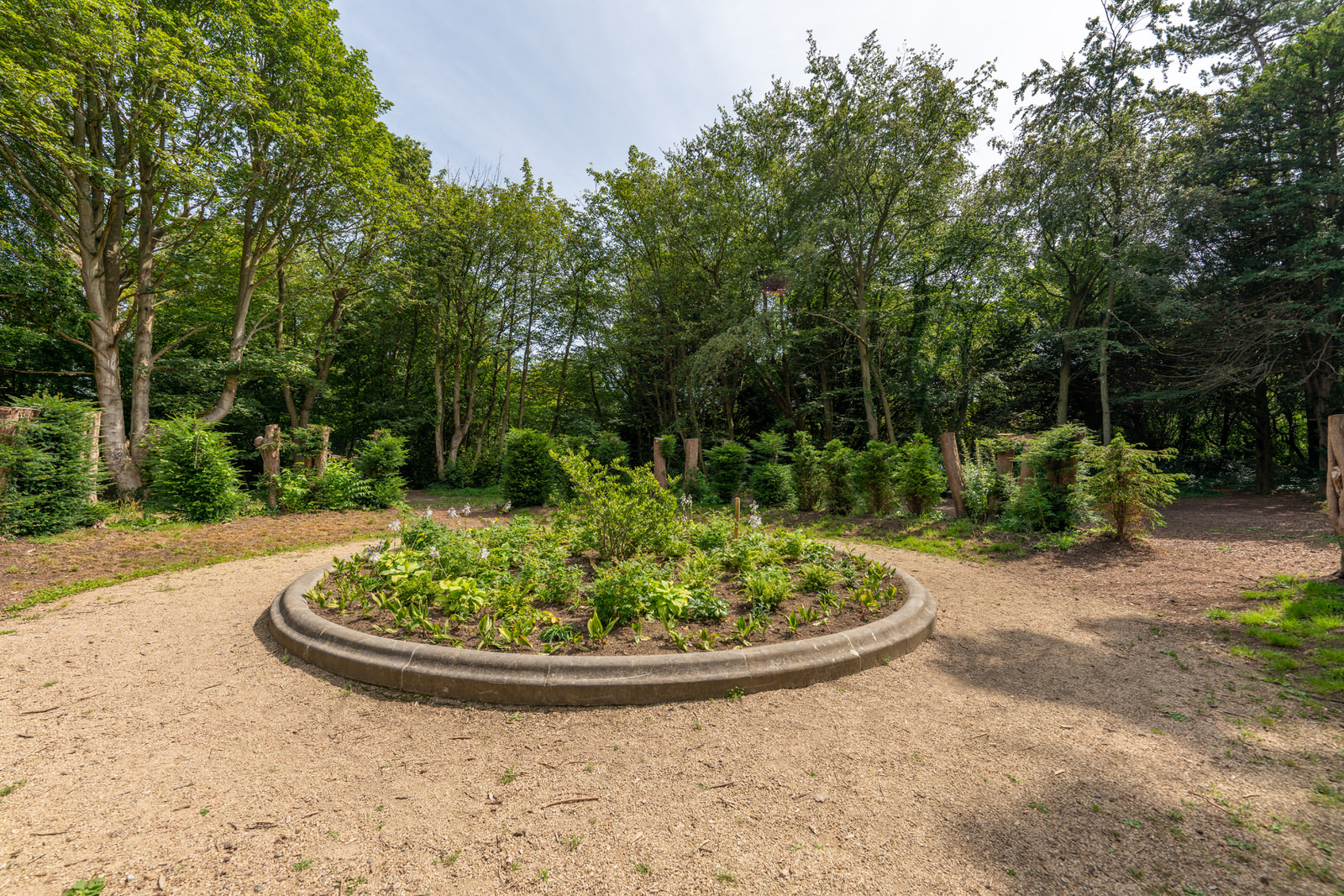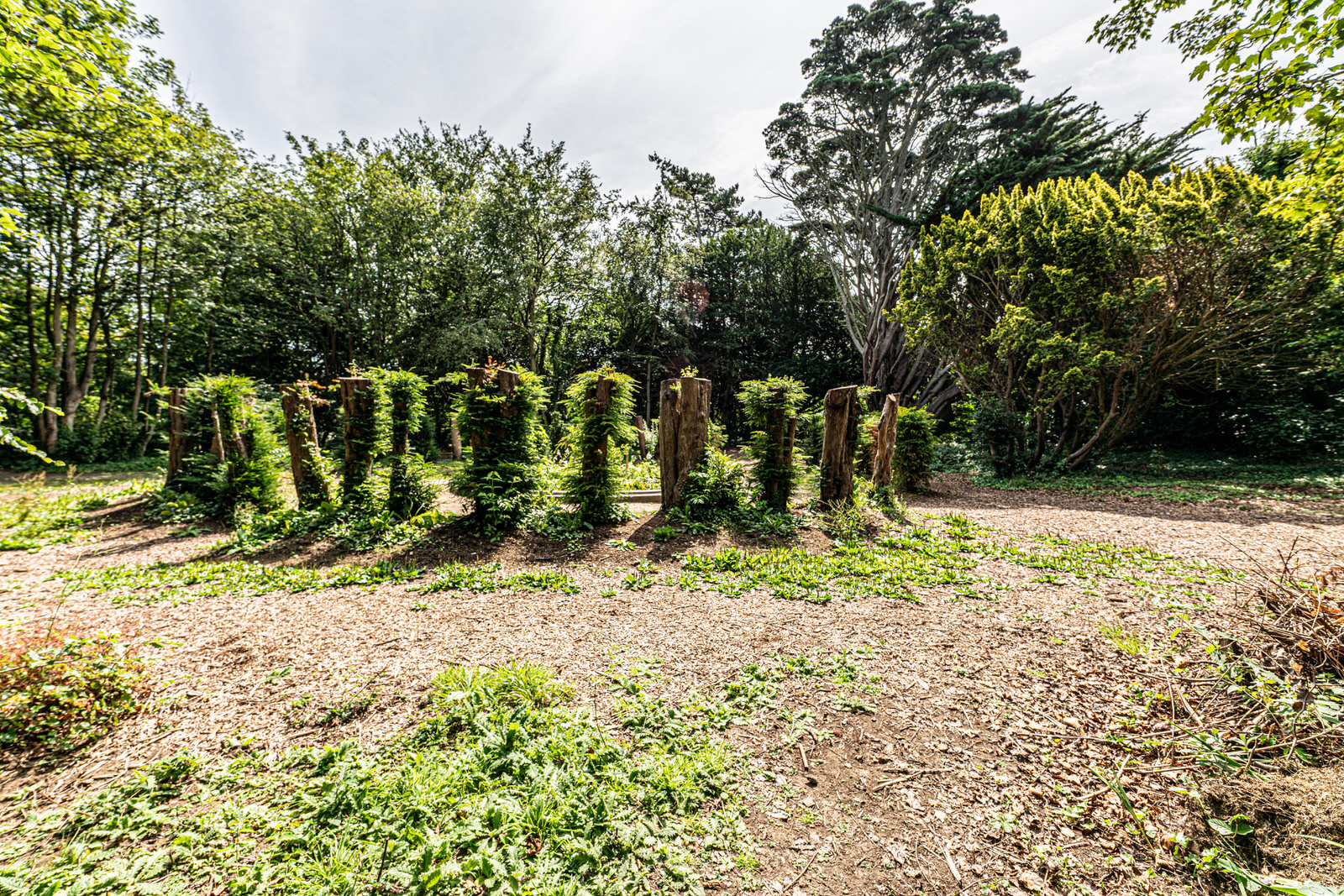THE YEW CIRCLE
As recently as two or three years ago I was getting more than woried about the future of the "follies" in St. Anne's park but it would appear that some restoration work is now ongoing.
In a quarter of the walled garden was a circular yew hedge with alcoves and arches in which stood allegorical Italian statues representing the five continents. These statues were reflected in the great circular marble basin which occupied the centre (Malins and Bowe, 1980). The 1939 auction
catalogue included these statues: "Lot 1471 – 4 carved stone figures representing the continents, on square bases with carved mouldings‟ (Adam, 1939).
There is still a basin at the Park, minus its central statue. The yew hedges survive in an overgrown state. An account from 1873 (W. Heale, 1873) describes the yew circle in detail: "On the east side of this [Dutch style flower] garden is an amphitheatre some 150 feet in circumference; the outer portion is a well-kept Yew hedge with five entrances; equidistant from each entrance are four marble statues representing Europe, Asia, Africa and America; Australia is not yet represented. The centre is a costly marble basin with fountain and stocked with gold and silver fish.‟
St. Annes is known for its follies, of which there are approximately ten, mainly around the Naniken River. The follies include a Herculanean Temple on a mock-ruined bridge abutment along the little river, which served as a tearoom for the family, a Pompeian Water Temple of Isis on the banks of the duck pond, and the Annie Lee Tower and Bridge near the chestnut walk. Other follies include the stone covering of Saint Anne's Well beside the duck pond, the Hermitage Bridge, the Yew Circle and Fountain Pool (behind the formal walled garden beside the house), a "rustic cave" and bridge, three rustic archways and a rockwork feature. A "Druidic Circle" of Giant's Causeway basalt was lost at an earlier stage. An unusual folly is the Roman style viewing tower which stands on the hill overlooking the duckpond. This started out as an observation tower on the roof of the original house. Later, the tower was removed during extensive refurbishment of St. Anne's house in about 1873 and placed in its current location. It is modelled on the Tomb of the Julii at Glanum near St. Rémy in France.
Many of the follies are in a neglected condition at present, with graffiti being an ongoing particular issue. For example, the Roman style viewing tower is graffiti-covered, has been closed for many years and is completely hidden by mature trees (it could only be revealed, and the view restored, by felling trees, which would be detrimental to the environment of the park, so an alternative proposal is that the tower be moved instead to the site of the old rockery, near the junction of James Larkin Road and Mount Prospect Avenue). In 2010, Dublin City Council, with the support of the Heritage Council, commissioned a strategy by conservation architects (Shaffrey and Associates) for the long-term conservation of these follies, and it is planned to implement this on a phased basis.
In a quarter of the walled garden was a circular yew hedge with alcoves and arches in which stood allegorical Italian statues representing the five continents. These statues were reflected in the great circular marble basin which occupied the centre (Malins and Bowe, 1980). The 1939 auction
catalogue included these statues: "Lot 1471 – 4 carved stone figures representing the continents, on square bases with carved mouldings‟ (Adam, 1939).
There is still a basin at the Park, minus its central statue. The yew hedges survive in an overgrown state. An account from 1873 (W. Heale, 1873) describes the yew circle in detail: "On the east side of this [Dutch style flower] garden is an amphitheatre some 150 feet in circumference; the outer portion is a well-kept Yew hedge with five entrances; equidistant from each entrance are four marble statues representing Europe, Asia, Africa and America; Australia is not yet represented. The centre is a costly marble basin with fountain and stocked with gold and silver fish.‟
St. Annes is known for its follies, of which there are approximately ten, mainly around the Naniken River. The follies include a Herculanean Temple on a mock-ruined bridge abutment along the little river, which served as a tearoom for the family, a Pompeian Water Temple of Isis on the banks of the duck pond, and the Annie Lee Tower and Bridge near the chestnut walk. Other follies include the stone covering of Saint Anne's Well beside the duck pond, the Hermitage Bridge, the Yew Circle and Fountain Pool (behind the formal walled garden beside the house), a "rustic cave" and bridge, three rustic archways and a rockwork feature. A "Druidic Circle" of Giant's Causeway basalt was lost at an earlier stage. An unusual folly is the Roman style viewing tower which stands on the hill overlooking the duckpond. This started out as an observation tower on the roof of the original house. Later, the tower was removed during extensive refurbishment of St. Anne's house in about 1873 and placed in its current location. It is modelled on the Tomb of the Julii at Glanum near St. Rémy in France.
Many of the follies are in a neglected condition at present, with graffiti being an ongoing particular issue. For example, the Roman style viewing tower is graffiti-covered, has been closed for many years and is completely hidden by mature trees (it could only be revealed, and the view restored, by felling trees, which would be detrimental to the environment of the park, so an alternative proposal is that the tower be moved instead to the site of the old rockery, near the junction of James Larkin Road and Mount Prospect Avenue). In 2010, Dublin City Council, with the support of the Heritage Council, commissioned a strategy by conservation architects (Shaffrey and Associates) for the long-term conservation of these follies, and it is planned to implement this on a phased basis.
BELOW IS THE SAME LOCATION PHOTOGRAPHED IN MAY 2011
St. Annes is known for its follies, of which there are approximately ten, mainly around the Naniken River. The follies include a Herculanean Temple on a mock-ruined bridge abutment along the little river, which served as a tearoom for the family, a Pompeian Water Temple of Isis on the banks of the duck pond, and the Annie Lee Tower and Bridge near the chestnut walk. Other follies include the stone covering of Saint Anne's Well beside the duck pond, the Hermitage Bridge, the Yew Circle and Fountain Pool (behind the formal walled garden beside the house), a "rustic cave" and bridge, three rustic archways and a rockwork feature. A "Druidic Circle" of Giant's Causeway basalt was lost at an earlier stage. An unusual folly is the Roman style viewing tower which stands on the hill overlooking the duckpond. This started out as an observation tower on the roof of the original house. Later, the tower was removed during extensive refurbishment of St. Anne's house in about 1873 and placed in its current location. It is modelled on the Tomb of the Julii at Glanum near St. Rémy in France.
Many of the follies are in a neglected condition at present, with graffiti being an ongoing particular issue. For example, the Roman style viewing tower is graffiti-covered, has been closed for many years and is completely hidden by mature trees (it could only be revealed, and the view restored, by felling trees, which would be detrimental to the environment of the park, so an alternative proposal is that the tower be moved instead to the site of the old rockery, near the junction of James Larkin Road and Mount Prospect Avenue). In 2010, Dublin City Council, with the support of the Heritage Council, commissioned a strategy by conservation architects (Shaffrey and Associates) for the long-term conservation of these follies, and it is planned to implement this on a phased basis.
Many of the follies are in a neglected condition at present, with graffiti being an ongoing particular issue. For example, the Roman style viewing tower is graffiti-covered, has been closed for many years and is completely hidden by mature trees (it could only be revealed, and the view restored, by felling trees, which would be detrimental to the environment of the park, so an alternative proposal is that the tower be moved instead to the site of the old rockery, near the junction of James Larkin Road and Mount Prospect Avenue). In 2010, Dublin City Council, with the support of the Heritage Council, commissioned a strategy by conservation architects (Shaffrey and Associates) for the long-term conservation of these follies, and it is planned to implement this on a phased basis.
THE YEW CIRCLE PHOTOGRAPHED IN AUGUST 2019



You will find links to buy products from Amazon, Google and other partners. If you click on these links, you’ll find that the URL includes a small extra piece of text which identifies that the click came from my websites. This text is an affiliate code, and it means that I get a small percentage of the money you spend if you choose to buy that product, or, in some cases, other products from the site soon after. These affiliate links help pay the costs of producing my websites and ensure that the content is free to you.
COPYRIGHT INFORMATION BELOW APPLIES ONLY TO PHOTOGRAPHS

This work by William Murphy aka Infomatique is licensed under a Creative Commons Attribution-NonCommercial-ShareAlike 4.0 International License.
Permissions beyond the scope of this license may be available at https://excellentstreetimages.com/in-the-year-twentytwenty/copyright/.

